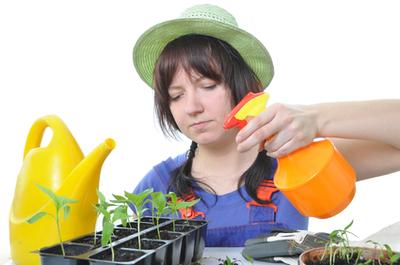How to Cut Down on Watering Time in the Garden
As summer nears, many gardeners face the challenge of proper watering due to restrictions imposed by many municipalities.
For many years we had a total ban on watering your gardens at all, here in Victoria Australia. All we could use was grey water from the laundry.
I lost 2 beautiful Willow trees and a Loquat tree. Very sad and frustrating times.
But in the last 18 months we have had rains that allow us to water with sprinkler systems again, as well as being able to hand water our precious gardens.
But some countries are just beginning to experience water restrictions and drought conditions, and it makes us all aware of the value water has to us.
If you're one of these gardeners experiencing water shortages or restrictions, don’t fret.
Cutting down on watering time doesn't mean allowing your plants to wilt and dry up.
It really is just a matter of creating a watering schedule that will not only work but also save you money. Here are some ways you can use:
Water sparingly.
When using a water can or hose, aim the water to the roots and not the leaves.
Plants absorb water through their root system and many gardeners waste too much time and a lot of water allowing the moisture to fall someplace else.
Catch excess water.
If you have hanging plants or pots placed in elevated areas, it might be a good idea to place other plants directly underneath.
Each time you water the plants above, those below can catch the excess water and use it instead, cutting down your watering time by at least half.
Choose plants to water.
Not every plant in your garden requires watering everyday.
Keep your daily watering to only the vegetables and fruit beds that do need consistent moisture to stop fruit splitting and spoiling.
Cacti and other succulents, for example, can survive well with infrequent watering.
Plants with established roots will do well with a deep watering once or twice a week.
Infrequent watering will also encourage deeper rooting, producing plants that are healthier and stronger.
Avoid shallow watering.
Despite appearances, shallow watering actually wastes more water than deep watering.
A light sprinkle of water, for example, will only last for a few hours, requiring you to water the plant all over again within hours.
Another problem is that if the atmosphere is too hot, the water will evaporate before it has the time to reach the roots so you'll have to water more frequently than you should.
It's not only ineffective, it is also wasteful. Go for deep watering once or twice a week instead.
Schedule watering.
The best watering times for plants are early mornings, just before the sun reaches its peak and late afternoons when the sun isn’t too hot.
The reason is simple: if you water during the hottest time of the day, water evaporates faster.
That means you might have to water again late in the afternoon on the same day.
Alternatively, some people prefer to water in the evenings, but be aware that this can cause some wet mold or mildew on some plants as they are sodden all night long.
If you have a 'dripper' watering system it is best to run that overnight when it is coolest, as otherwise the tiny droplets of water released will simply evaporate in the heat of the day without ever wetting the soil and plant roots.
Use watering devices effectively.
Other than the sprinkler, there are also other watering devices that will help you cut down on watering time and save money.
Soaker hoses, for example, 'weep' moisture during a specified length of time and are very effective with flowerbeds and vegetable plots.
Root feeders, which are buried several inches below the ground surface, are great for shrubs and trees.
Give your plants some shade
After my biggest trees died in the drought I have had to compensate for the loss of shade that these beautiful trees gave to the rest of the garden.
So to help take the heat off the bushes in summer I have arranged for starposts to surround some garden beds and I have tied Shadecloth to them with wire.
They need to be well secured or you will lose the lot in any strong gusts of wind.
I'm finding that this shadecloth gives much relief to the plants from the direct sun burning them, making them stronger and better able to cope with the sheer heat of summer, and requiring less watering as well.
You can learn much more about water saving and going green when you read the rest of our information here about: How to save water at home and in the garden.
There is so much that you can do when you go green at home that helps both the environment and saves you money as well.
Join in and write your own page! It's easy to do. How? Simply click here to return to Going Green.

"Power Tips" magazine is back!
You Get A Free Complete Self Help Report delivered to your email box every edition, plus you get a free PLR article and other great gifts!
SUBSCRIBE BELOW ... I promise you will want to USE what you learn!
I really want to know what you think of this site, this page, and to hear your tips or suggestions about it.
So please share your story or simply add a Comment in the comment box.
If you feel that the information on this page has been useful to you please give it a Like or share it with your friends - thanks!!
"You are a life Saver!!
I recently discovered this site and I can tell you that my life has not been the same. I now come here EVERYDAY and spend at least 1 hour.
I used to spend that time browsing online fashion and beauty
magazine which just means that I spend more. Now I have replaced that
habit with coming here.
In future I will think about contributing articles as well. Thank you! Thank you!! Thank you!!! and God bless"
Contact Us | About Us | Terms of Use | Privacy Policy | FAQ | Testimonials
Amazon and the Amazon logo are trademarks of Amazon.com, Inc. or its affiliates. As an Amazon Associate I earn from qualifying purchases. Product prices and availability are accurate as of the date/time
indicated and are subject to change. Any price and availability
information displayed on [relevant Amazon Site(s), as applicable] at the
time of purchase will apply to the purchase of this product.









